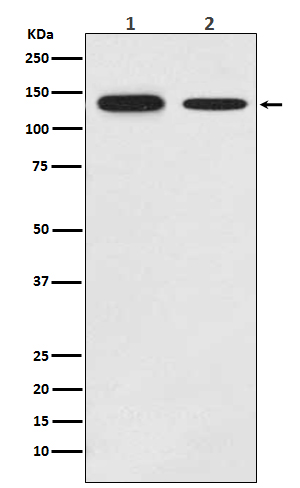Growth hormone receptor Antibody
Rabbit mAb
- SPECIFICATION
- CITATIONS
- PROTOCOLS
- BACKGROUND

Application
| WB, FC, ICC |
|---|---|
| Primary Accession | P10912 |
| Reactivity | Rat |
| Clonality | Monoclonal |
| Other Names | GH-binding protein; GHBP; GHR; Serum binding protein; Somatotropin receptor; |
| Isotype | Rabbit IgG |
| Host | Rabbit |
| Calculated MW | 71500 Da |
| Dilution | WB 1:500~1:2000 ICC/IF 1:50~1:200 FC 1:100 |
|---|---|
| Purification | Affinity-chromatography |
| Immunogen | A synthesized peptide derived from human Growth hormone receptor |
| Description | Receptor for pituitary gland growth hormone involved in regulating postnatal body growth. On ligand binding, couples to the JAK2/STAT5 pathway. The soluble form (GHBP) acts as a reservoir of growth hormone in plasma and may be a modulator/inhibitor of GH signaling. Isoform 2 up-regulates the production of GHBP and acts as a negative inhibitor of GH signaling. |
| Storage Condition and Buffer | Rabbit IgG in phosphate buffered saline , pH 7.4, 150mM NaCl, 0.02% sodium azide and 50% glycerol. Store at +4°C short term. Store at -20°C long term. Avoid freeze / thaw cycle. |
| Name | GHR |
|---|---|
| Function | Receptor for pituitary gland growth hormone (GH1) involved in regulating postnatal body growth (PubMed:1549776, PubMed:2825030, PubMed:8943276). On ligand binding, couples to the JAK2/STAT5 pathway (PubMed:1549776, PubMed:15690087, PubMed:2825030, PubMed:8943276). |
| Cellular Location | Cell membrane; Single-pass type I membrane protein. Note=On growth hormone binding, GHR is ubiquitinated, internalized, down-regulated and transported into a degradative or non-degradative pathway {ECO:0000250|UniProtKB:P19941} [Growth hormone-binding protein]: Secreted. Note=Complexed to a substantial fraction of circulating GH. |
| Tissue Location | Expressed in various tissues with high expression in liver and skeletal muscle. [Isoform 4]: Predominantly expressed in kidney, bladder, adrenal gland and brain stem (PubMed:1569971). Highly expressed in placental villi (PubMed:1569971, PubMed:8360189) |

Thousands of laboratories across the world have published research that depended on the performance of antibodies from Abcepta to advance their research. Check out links to articles that cite our products in major peer-reviewed journals, organized by research category.
info@abcepta.com, and receive a free "I Love Antibodies" mug.
Provided below are standard protocols that you may find useful for product applications.
If you have used an Abcepta product and would like to share how it has performed, please click on the "Submit Review" button and provide the requested information. Our staff will examine and post your review and contact you if needed.
If you have any additional inquiries please email technical services at tech@abcepta.com.













 Foundational characteristics of cancer include proliferation, angiogenesis, migration, evasion of apoptosis, and cellular immortality. Find key markers for these cellular processes and antibodies to detect them.
Foundational characteristics of cancer include proliferation, angiogenesis, migration, evasion of apoptosis, and cellular immortality. Find key markers for these cellular processes and antibodies to detect them. The SUMOplot™ Analysis Program predicts and scores sumoylation sites in your protein. SUMOylation is a post-translational modification involved in various cellular processes, such as nuclear-cytosolic transport, transcriptional regulation, apoptosis, protein stability, response to stress, and progression through the cell cycle.
The SUMOplot™ Analysis Program predicts and scores sumoylation sites in your protein. SUMOylation is a post-translational modification involved in various cellular processes, such as nuclear-cytosolic transport, transcriptional regulation, apoptosis, protein stability, response to stress, and progression through the cell cycle. The Autophagy Receptor Motif Plotter predicts and scores autophagy receptor binding sites in your protein. Identifying proteins connected to this pathway is critical to understanding the role of autophagy in physiological as well as pathological processes such as development, differentiation, neurodegenerative diseases, stress, infection, and cancer.
The Autophagy Receptor Motif Plotter predicts and scores autophagy receptor binding sites in your protein. Identifying proteins connected to this pathway is critical to understanding the role of autophagy in physiological as well as pathological processes such as development, differentiation, neurodegenerative diseases, stress, infection, and cancer.


